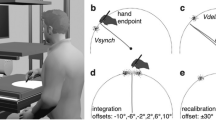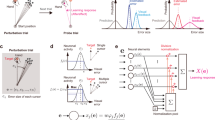Abstract
The principle of 'divide-and-conquer', the decomposition of a complex task into simpler subtasks each learned by a separate module, has been proposed as a computational strategy during learning1–3. We explore the possibility that the human motor system uses such a modular decomposition strategy to learn the visuomotor map, the relationship between visual inputs and motor outputs. Using a virtual reality system, subjects were exposed to opposite prism-like visuomotor remappings—discrepancies between actual and visually perceived hand locations— for movements starting from two distinct locations. Despite this conflicting pairing between visual and motor space, subjects learned the two starting-point-dependent visuomotor mappings and the generalization of this learning to intermediate starting locations demonstrated an interpolation of the two learned maps. This interpolation was a weighted average of the two learned visuomotor mappings, with the weighting sigmoidally dependent on starting location, a prediction made by a computational model of modular learning known as the "mixture of experts"1. These results provide evidence that the brain may employ a modular decomposition strategy during learning.
This is a preview of subscription content, access via your institution
Access options
Subscribe to this journal
Receive 51 print issues and online access
$199.00 per year
only $3.90 per issue
Buy this article
- Purchase on Springer Link
- Instant access to full article PDF
Prices may be subject to local taxes which are calculated during checkout
Similar content being viewed by others
References
Jacobs, R. A., Jordan, M. I., Nowlan, S. J. & Hinton, G. E. Adaptive mixture of local experts. Neur. Comp. 3, 79–87 (1991).
Jordan, M. I. & Jacobs, R. A. Hierarchical mixtures of experts and the EM algorithm. Neur. Comp. 6, 181–214 (1994).
Cacciatore, T. W. & Nowlan, S. J. Mixtures of controllers for jump linear and non-linear plants. In Advances in Neural Information Processing Systems 6 (eds Cowan, J. D., Tesauro, G. & Alspector, J.) 719–726 (Morgan Kaufmann, San Francisco, 1994).
Jacobs, R. A., Jordan, M. I. & Barto, A. G. Task decomposition through competition in a modular connectionist architecture: the what and where vision tasks. Cogn. Sci. 15, 219–250 (1991).
Graybiel, A. M., Aosaki, T., Flaherty, A. W. & Kimura, M. The basal ganglia and adaptive motor control. Science 265, 1826–1831 (1994).
McGonigle, B. & Flook, J. Long-term retention of single and multistate prismatic adaptation by humans. Nature 272, 364–366 (1978).
Welch, R. B., Bridgeman, B., Anand, S. & Browman, K. E. Alternating prism exposure causes dual adaptation and generalization to a novel displacement. Percept. Psychophys. 54, 195–204 (1993).
Clower, D. M. et al. Role of posterior parietal cortex in the recalibration of visually guided reaching. Nature 383, 618–621 (1996).
Kohler, I. Development and alterations of the perceptual world: conditioned sensations. Proc. Austrian Acad. Sci. 227, 1–118 (1951).
Hay, J. C. & Pick, H. L. Gaze-contingent prism adaptation: optical and motor factors. J. Exp. Psychol. 72, 640–648 (1966).
Shelhamer, M., Robinson, D. A. & Tan, H. S. Context-specific gain switching in the human vestibuloocular reflex. Ann. NY Acad. Sci. 656, 889–891 (1991).
Baker, J. F., Perlmutter, S. I., Peterson, B. W., Rude, S. A. & Robinson, F. R. Simultaneous opposing adaptive changes in cat vestibulo-ocular reflex directions for two body orientations. Exp. Brain Res. 69, 220–224 (1987).
Gandolfo, F., Mussa-Ivaldi, F. A. & Bizzi, E. Motor learning by field approximation. Proc. Natl Acad. Sci. USA 93, 3843–3846 (1996).
Kravitz, J. H. & Yaffe, F. Conditioned adaptation to prismatic displacement with a tone as the conditional stimulus. Percept. Psychophys. 12, 305–308 (1972).
Kravitz, J. H. Conditioned adaptation to prismatic displacement. Percept. Psychophys. 11, 38–42 (1972).
Welch, R. B. Discriminative conditioning of prism adaptation. Percept. Psychophys. 10, 90–92 (1971).
Martin, T. A., Keating, J. G., Goodkin, H. P., Bastian, A. J. & Thach, W. T. Throwing while looking through prisms, II. Specificity and storage of multiple gaze-throw calibrations. Brain 119, 1199–1211 (1996).
Wolpert, D. M., Ghahramani, Z. & Jordan, M. I. An internal model for sensorimotor integration. Science 269, 1880–1882 (1995).
Andersen, R. A., Esseck, C. & Siegel, R. Encoding of spatial location by posterior parietal neurons. Science 230, 456–458 (1985).
Soechting, J. F. & Flanders, M. Sensorimotor representations for pointing to targets in three-dimensional space. J. Neurophysiol. 62, 582–594 (1989).
Kalaska, J. F. & Crammond, D. J. Cerebral cortical mechanisms of reaching movements. Science 255, 1517–1523 (1992).
Bridle, J. S. Probabilistic interpretation of feedforward classification network outputs, with relationships to statistical pattern recognition. In Neuro-computing: Algorithms, Architectures, and Applications (eds Fougelman-Soulie, F. & Herault, J.) 227–236 (Springer, Berlin, 1990).
Bedford, F. Constraints on learning new mappings between perceptual dimensions. J. Exp. Psychol. 15, 232–248 (1989).
Imamizu, H., Uno, Y. & Kawato, M. Internal representations of the motor apparatus: implications from generalization in visuomotor learning. J. Exp. Psychol. 21, 1174–1198 (1995).
Ghahramani, Z., Wolpert, D. M. & Jordan, M. I. Generalization to local remappings of the visuomotor coordinate transformation. J. Neurosci. 16, 7085–7096 (1996).
Georgopoulos, A. P., Schwartz, A. B. & Kettner, R. E. Neuronal population coding of movement direction. Science 233, 1416–1419 (1986).
Georgopoulos, A. P. Current issues in directional motor control. Trends Neurosci. 18, 506–510 (1995).
Bizzi, E., Mussa-Ivaldi, F. A. & Giszter, S. Computations underlying the execution of movement: A biological perspective. Science 253, 287–291 (1991).
Wolpert, D. S., Ghahramani, Z. & Jordan, M. I. Are arm trajectories planned in kinematic or dynamic coordinates? An adaptation study. Exp. Brain Res. 103, 460–470 (1995).
Efron, B. The Jacknife, the Bootstrap and Other Resampling Plans (Society for Industrial and Applied Mathematics, Philadelphia, 1982).
Author information
Authors and Affiliations
Rights and permissions
About this article
Cite this article
Ghahramani, Z., Wolpert, D. Modular decomposition in visuomotor learning. Nature 386, 392–395 (1997). https://doi.org/10.1038/386392a0
Received:
Accepted:
Issue Date:
DOI: https://doi.org/10.1038/386392a0
This article is cited by
-
Learning a reach trajectory based on binary reward feedback
Scientific Reports (2021)
-
Learning to find spatially reversed sounds
Scientific Reports (2020)
-
3D human arm reaching movement planning with principal patterns in successive phases
Journal of Computational Neuroscience (2020)
-
How different effectors and action effects modulate the formation of separate motor memories
Scientific Reports (2019)
-
Learning and adaptation in speech production without a vocal tract
Scientific Reports (2019)
Comments
By submitting a comment you agree to abide by our Terms and Community Guidelines. If you find something abusive or that does not comply with our terms or guidelines please flag it as inappropriate.



